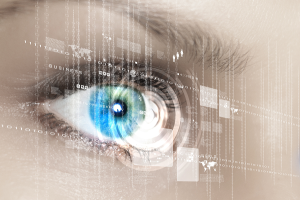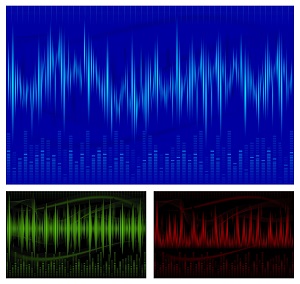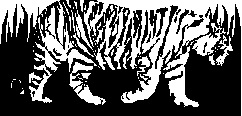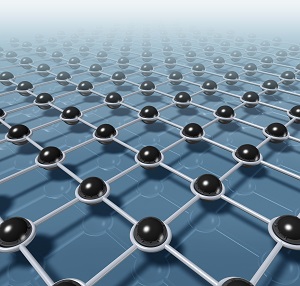21 Feb Pattern Recognition in Two Dimensions
 Perceptual Grid
Perceptual Grid
We live in three dimensional space, and understanding three dimensions is critical to our ability to go places and do things, but we comprehend things in many dimensions. Our senses, however, tend to flatten things out. Images are projected on our light-sensitive retinas in exactly two-dimensional patterns. The rods and cones possess light-sensitive rhodopsin and iodopsin pigments which respond to light within the visual spectrum by “bleaching.” The bleaching stimulates the rods and cones to initiate impulses that are transmitted to the optic nerve at the back of the brain, inverted somewhere in the process, and interpreted. Without probing deeper into the physiology or chemistry of vision, we can still consider two interesting facts:
- The impulses transmitted to the optic nerve are very similar to all other impulses in the brain; and
- The resulting set of signals can be shown as a two-dimensional grid.
For both humans and computers, two dimensions are easier to process than three.
| Understanding Context Cross-Reference |
|---|
| Click on these Links to other posts and glossary/bibliography references |
|
|
|
| Prior Post | Next Post |
| Learning Cause and Effect | Understanding What we See |
| Definitions | References |
| understanding sense | Btitannica on Rhodopsin |
| stimulus impulse | Thinkquest.org on Color Vision |
| pattern recognition | David Hubel on Bleaching |
 Pattern recognition applies to all the senses. The connections between our ears and our brains are very different from the visual pathways, but the recognition and interpretation processes are similar. Tonal frequency of vibrations are shown at right as two-dimensional patterns. Wave-like sound patterns elicit electrochemical modulations (activation) that are interpreted in the receptive centers of the brain. The physiology or chemistry of audio interpretation is like vision:
Pattern recognition applies to all the senses. The connections between our ears and our brains are very different from the visual pathways, but the recognition and interpretation processes are similar. Tonal frequency of vibrations are shown at right as two-dimensional patterns. Wave-like sound patterns elicit electrochemical modulations (activation) that are interpreted in the receptive centers of the brain. The physiology or chemistry of audio interpretation is like vision:
- The impulses transmitted to the receptive centers are very similar to all other impulses in the brain; and
- The resulting set of signals can be represented as a two-dimensional grid (though it is much more abstract than two-dimensional images).
In addition to pitch, tones have other meaningful attributes, such as timbre, color and quality. These attributes can be represented in 2-D space, for example as they are in a midi sequencing program.
Converting Stimuli
 How can living things make sense out of electrical impulses generated by the network of rods and cones at the back of the eye or generated by modulated vibrations in the inner ear? Nobody knows! The discussion of simple, complex and hypercomplex cells in Section 3 begins to answer the question, but the complete answer is still elusive. Furthermore, in images that are not full color or that do not show depth well, or are camouflaged as in the example of the Siberian tiger image, we are really good at picking things out. This is an amazing capability; and it is possessed by creatures with a variety of brain sizes and shapes.
How can living things make sense out of electrical impulses generated by the network of rods and cones at the back of the eye or generated by modulated vibrations in the inner ear? Nobody knows! The discussion of simple, complex and hypercomplex cells in Section 3 begins to answer the question, but the complete answer is still elusive. Furthermore, in images that are not full color or that do not show depth well, or are camouflaged as in the example of the Siberian tiger image, we are really good at picking things out. This is an amazing capability; and it is possessed by creatures with a variety of brain sizes and shapes.
This is a convenient place to borrow findings from artificial neural network research to develop a theory. Many artificial neural systems (ANS) have been designed to functionally mimic the way the brain responds to input from the ears or the eyes. Such ANS systems have been used to act as drivers for autonomous land vehicles and have proven sufficiently capable of recognizing the edges of roadways, other cars and other things that make them approach and sometimes exceed human driving abilities.
While this is only a theory, it seems that if ANS-type systems can enable computers to do tasks the brain can do, then the automated processes must be at least analogous to, if not direct imitations of, the processes in the brain.
Given small video cameras hooked to a neural network, ALVs can navigate even on dirt roads without center or edge lines.
Progressive Linkages
 After he is born, Yorrick’s newly activated senses of sight and taste – in conjunction with his previously developed and now more acutely stimulated senses of touch, hearing and smell – receive patterns of input from the outside world. He learns about these patterns by relating them to knowledge he has previously acquired. The image of mom’s face, for example, becomes linked with his previously acquired knowledge of her voice and her kindness in feeding him. Other images will be perceived and gradually categorized by the way in which they relate to prior knowledge.
After he is born, Yorrick’s newly activated senses of sight and taste – in conjunction with his previously developed and now more acutely stimulated senses of touch, hearing and smell – receive patterns of input from the outside world. He learns about these patterns by relating them to knowledge he has previously acquired. The image of mom’s face, for example, becomes linked with his previously acquired knowledge of her voice and her kindness in feeding him. Other images will be perceived and gradually categorized by the way in which they relate to prior knowledge.
From day to day, Yorrick learns to attend to those stimuli that are most meaningful. This phenomenon of selective attention enables Yorrick to filter out environmental noise and begin to learn all the things he needs to know. At first, he requires frequent repetition to fully grasp the significance of new patterns of stimuli and establish relations with his prior knowledge. As his mind fills up with information, his learning process progresses faster and faster because he is able to associate new things more quickly with his expanding repertoire of existing knowledge.
Just as elements bind to form the chemical structures of molecules and compounds, concepts naturally bind to one another in associative patterns.
- Some are hierarchical: self – sibling – parent – grandparent.
- Some are causal: feel bad – cry – eat – feel good.
- Some are functional: cars – go places / trees – stay put.
- Some are descriptive: water – blue / cat – furry soft
As Yorrick’s network of knowledge grows, even though he is not aware of the extent to which everything becomes interconnected, all these different types of knowledge reinforce and strengthen one another. More to come on this topic as we see how to model these associative patterns in automata.
| Click below to look in each Understanding Context section |
|---|








